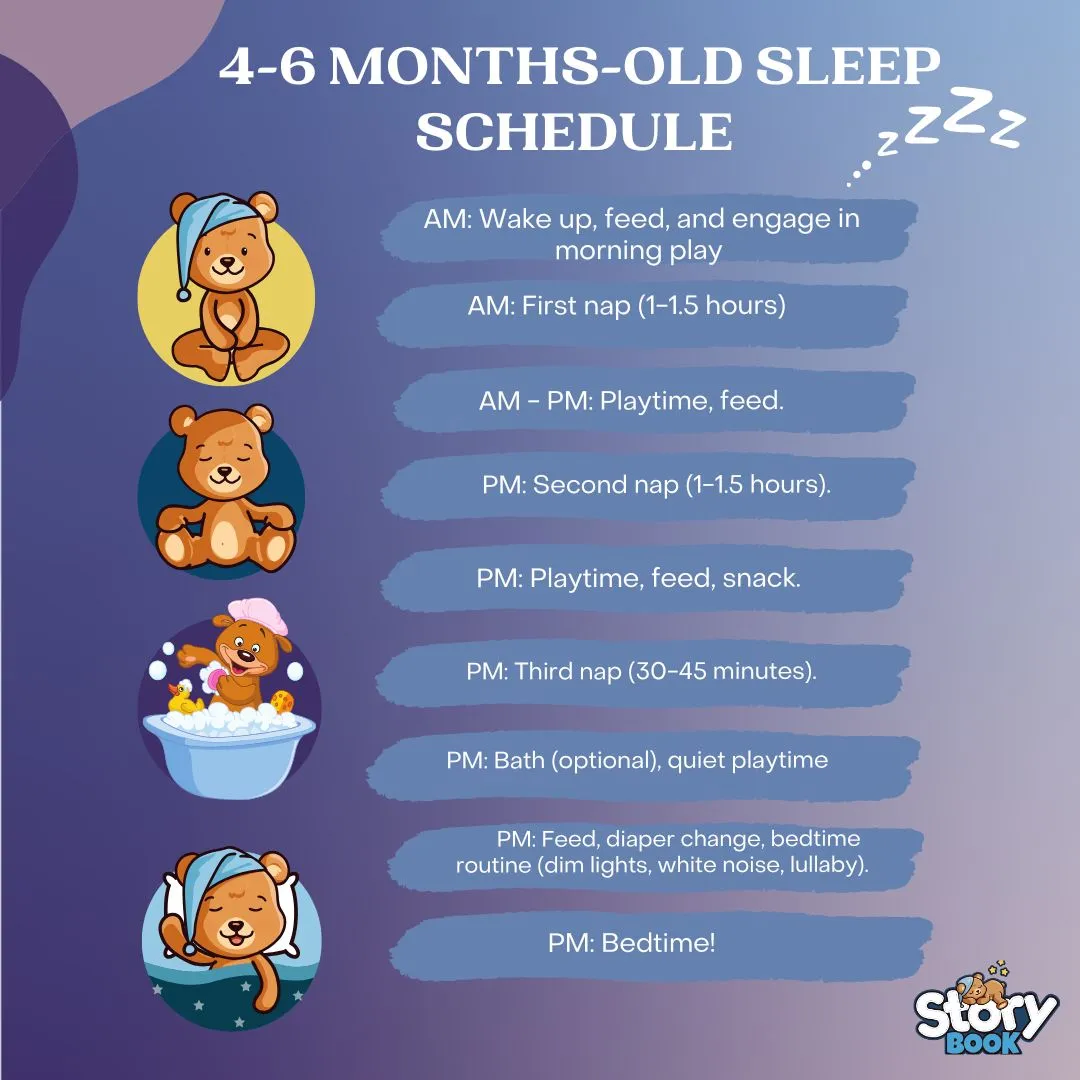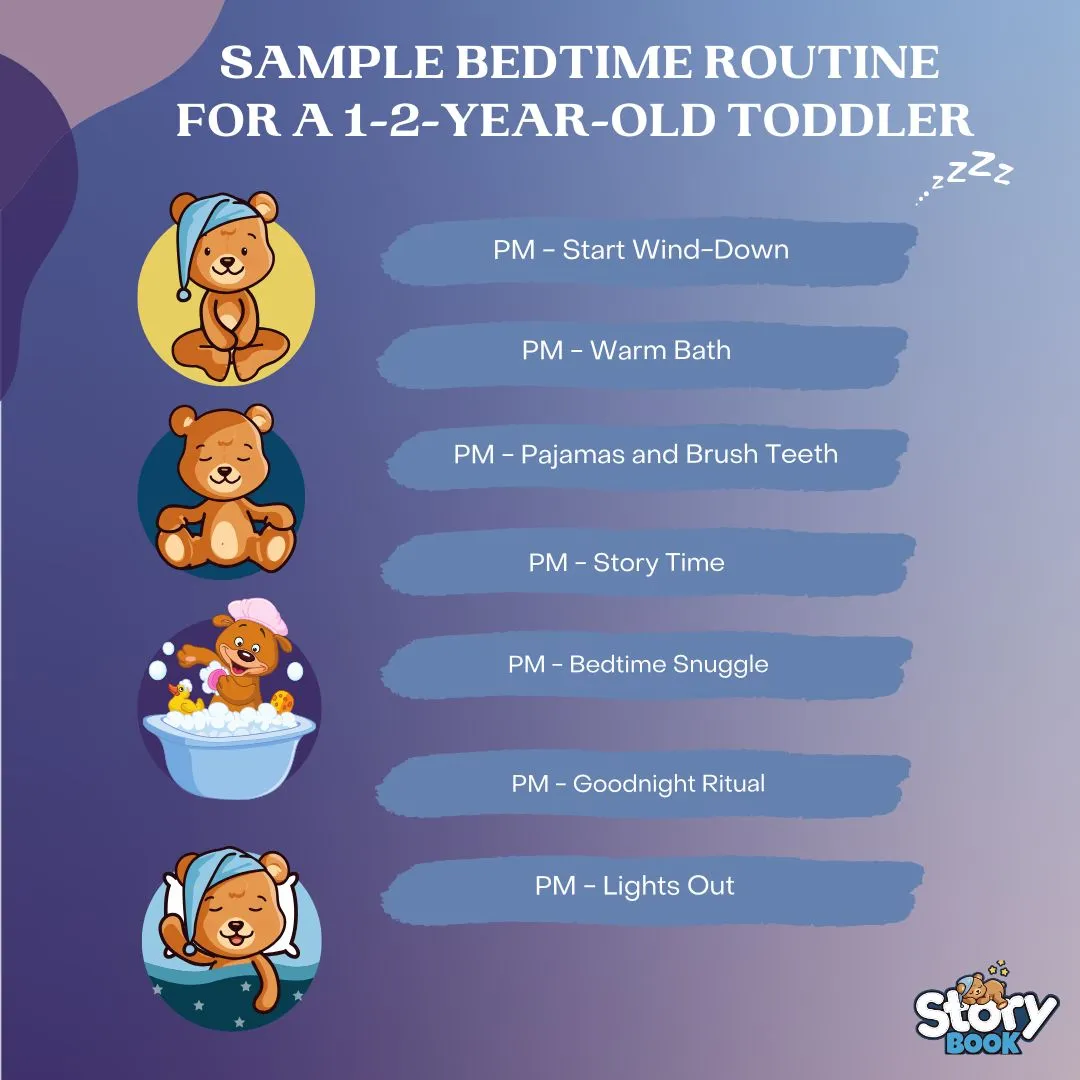Creating a practical bedtime routine for kids can improve their sleep quality and overall well-being.
In this guide, we’ll explore what a bedtime routine is, share essential do's and don'ts for success, provide examples tailored to different age groups. and provide tips based on valuable insights shared by Deborah Pedrick, creator of the Child Sleep Consultant Certification program, to ensure bedtime is a calm and positive experience for both parents and kids.
Let’s get started! 🔎⬇️
What is a bedtime routine for kids?
A bedtime routine consists of a series of activities you follow with your child each night before bed.
This routine may include tasks like giving your child a bath, changing their diaper or clothes, helping them into pajamas, and finishing with a calming activity such as reading a bedtime story.
These steps help signal to your child that it's time to relax and prepare for sleep.
Why is a bedtime routine important for a child?
A bedtime routine is important for children because it fosters better sleep patterns, improves mood, and contributes to cognitive and emotional development.
Regular routines can help regulate sleep-wake cycles and reduce sleep problems.
Consistent bedtime habits are linked to improved attention, behavior, and family functioning.
According to Deborah Pedrick, co-founder of the International Association of Child Sleep Consultants and Founder/President of the Family Sleep Institute, parents often underestimate the importance of a bedtime routine and can struggle to get their child to sleep.
Bedtime can take hours without a routine, resulting in very overtired children and cranky parents.
Research shows the importance of sleep for overall health and well-being and the value of a bedtime routine in teaching children to fall asleep on their own and sleep for longer stretches at night.
How to create a positive bedtime routine for your child?
Establishing a positive bedtime routine for your child can make bedtime smoother and more enjoyable.
By creating a predictable routine, children feel more secure and are better prepared for sleep.
Incorporating activities that are calming and consistent helps to reinforce this routine.
For added support, you can use printable bedtime routine charts for kids to help guide them through each step and make bedtime a positive experience.
1. Choose a bedtime that works for your child
Selecting the right bedtime is key to ensuring your child gets the rest they need for their age and development.
Whether it's a newborn, infant, toddler, preschooler, or school-age child, their sleep needs differ.
Establishing a consistent bedtime that suits their age group helps create a sense of routine and sets the stage for a smoother, more restful night.
Even though this chart shows specific times per age, it´s important to highlight that there are no specific bedtimes as all children are different.
Dr. Deborah Pedrick in her teachings shared that we should determine bedtime based on the quality of sleep during the day (for napping children), watching their child's sleep cues/behaviors towards the end of the day, and starting the bedtime routine before they become overtired.
2. Create a relaxing environment
A calm and comfortable environment is crucial for a restful night's sleep. According to Penn State Extension, a peaceful setting can significantly reduce stress for children and make bedtime smoother.
A consistent, peaceful environment helps children feel safe and secure, which can improve their sleep quality and bedtime routine. Here are a few key factors to consider:
- 🔦 Light: Dim the lights to signal that it's time for sleep. Blackout curtains or soft nightlights can help reduce distractions.
- 🌡️ Temperature: Keep the room cool, ideally between 65-70°F (18-21°C), to prevent overheating and discomfort.
- 🎵 Noise: Limit noise, or use a white noise machine to drown out any disruptive sounds that may keep your child awake.
- 🛏️ Mattress: Dr. Deborah Pedrick recommends ensuring the mattress is firm to create a safe foundation for sleep.
3. Start bedtime with a calming bath
A soothing bath is a great way to signal the start of your child’s bedtime routine.
It helps them unwind and relax after a long day.
Follow up with brushing their teeth to maintain good hygiene.
Encourage your child to use the bathroom, if needed, to avoid waking up during the night.
Finally, let them put on their favorite pajamas to add a sense of comfort and routine, making the transition to bedtime smoother.
4. Include relaxing activities
Engaging in calming activities before bed helps your child transition into sleep more easily. Consider these options:
- Massage with story
A gentle massage can help your child relax. Pair it with a bedtime story like “Ana, It’s Time to Go to Bed” to make the experience even more soothing. Explore the full story at the Storybook App.

- Lullabies or white noise
Soft lullabies or white noise can create a peaceful atmosphere that encourages sleep.
- Reading a book
Choose a calming book to read aloud, helping to wind down their thoughts.
- Talking about their day
Spend a few minutes discussing their day, which can help ease any lingering worries and promote a sense of closure before sleep.
5. Light off!
The final step in the bedtime routine is turning off the lights.
Dr. Deborah Pedrick recommends dimming the room or using a small nightlight to signal that it’s time for sleep.
Using nightlights in warm tones, such as orange or yellow, is best to create a cozy atmosphere and improve sleep.
This darkness promotes the production of melatonin, the hormone that regulates sleep, allowing your child to drift off peacefully.
Make this step consistent every night to reinforce the bedtime routine.
Do's and don'ts of a successful bedtime routine for kids
According to the American Academy of Sleep Medicine, a successful bedtime routine helps children unwind and transition into sleep more easily.
It provides a sense of security and consistency, both crucial for developing healthy sleep habits.
Following certain do's and avoiding common don'ts can make bedtime a smoother and more pleasant experience for both parents and kids.
Do's
✅Establish a consistent bedtime schedule
✅Include calming activities, such as reading or a warm bath
✅Create a relaxing sleep environment
Don'ts
❌Avoid stimulating activities, such as screen time, close to bedtime
❌Don’t rush through the routine, as this can cause stress
❌Steer clear of sugary snacks or drinks before bed
Age-appropriate bedtime routines for kids examples
Each stage of a child’s development requires different activities to ensure a peaceful transition to bed.
In this section, you'll find examples of routines for various age groups, from newborns to school-age children, that cater to their unique needs.
For more details and to customize routines for your child, check out our age-appropriate bedtime routines for kids.
Bedtime routine for babies
For creating a bedtime routine for babies, you can refer to the basic principles of Bedtime routine for babies (4 to 11 months).
A typical routine might include a calming bath, changing into pajamas, feeding, and reading or singing before turning off the lights. Each activity should last around 10 to 15 minutes to avoid overstimulation.

Tips for babies
- Feeding before sleep: Offering a feeding before bedtime can help babies feel full and relaxed, making it easier for them to fall asleep. For breastfeeding or bottle-feeding, this step often becomes a comforting part of the bedtime routine, helping babies settle down for the night.
- Keep the environment calm: Ensure the room is dimly lit, quiet, and at a comfortable temperature. White noise machines or soft music can also help create a peaceful sleeping environment.
Bedtime routine for toddlers
This visually appealing bedtime routine schedule for toddlers aged 1 to 2 years offers a simple guide to help parents establish a consistent and calming routine.
By following this schedule, you can ensure your toddler has a smooth transition from dinner to bedtime, with activities like playtime, bath, brushing teeth, and a bedtime story.
To customize this routine for your child, explore our Bedtime routine for toddler (1 to 2 years) section.

Tips for toddlers
- Leave them some responsibilities
Toddlers often assert their independence by resisting bedtime. To reduce stalling, offer them choices like picking out their pajamas or selecting a bedtime story.
Making the routine more fun and giving them control over small decisions can help ease the process. When it's time for lights-out, calmly say goodnight and leave the room.
- Offer a comfort item
Separation anxiety is common for toddlers. Introducing a favorite stuffed animal or comfort blanket can provide extra reassurance, helping them feel secure when you leave the room.
- Create a bedtime routine charts
Visual charts can help toddlers follow their bedtime routine. These charts make the process feel more structured and allow toddlers to check off each step, giving them a sense of accomplishment and making bedtime smoother.
Bedtime routine for teens
Creating a bedtime routine for teens is important to help them manage their sleep schedule and improve their overall well-being.
For more information, visit our Bedtime routine for school-age children (from 6 years and on) section. Here's a suggested schedule:

By following consistent steps and setting the right environment, bedtime can transform from a struggle into a peaceful experience.
If you're facing challenges, check out our guide on how to handle situations where bedtime is a nightmare for more helpful advice.
Tips for school-age children
- Limit screen time
Encourage your child to turn off screens at least 30 minutes before bedtime. Exposure to blue light from devices can interfere with their ability to fall asleep, so replacing screen time with relaxing activities like reading can promote better sleep.
- Include a morning routine
A structured morning routine can help set the tone for the day and make bedtime more predictable. When children start their day on a good note, it can lead to a smoother transition to bed. For more details, check out our guide on creating an effective morning routine for kids.

Written By
Entrepreneur mum. I created Storybook: Bedtime Stories the #1 app in over 90 countries. I have been able to help families with the app and through my social media influence. I also created a Facebook group with over 12,000 moms where we support each other.
References
- Mindell, J. A., & Williamson, A. A. (2017). Benefits of a bedtime routine in young children: Sleep, development, and beyond. Sleep Medicine Reviews, 40, 93-108. https://doi.org/10.1016/j.smrv.2017.09.003
- Better Kid Care. (n.d.). Creating a peaceful environment for young children. Penn State Extension. https://extension.psu.edu/programs/betterkidcare/early-care/tip-pages/all/creating-a-peaceful-environment-for-young-children
- American Academy of Sleep Medicine. (2015). Bedtime routines for young children: Overcoming sleep problems. Journal of Clinical Sleep Medicine, 11(7), 757-759. https://doi.org/10.5664/jcsm.4782
- Mindell, J. A., Li, A. M., Sadeh, A., Kwon, R., & Goh, D. Y. T. (Year). Bedtime routines for young children: A dose-dependent association with sleep outcomes.
- Mindell, J. A., Leichman, E. S., Lee, C., Williamson, A. A., & Walters, R. M. (Year). Implementation of a nightly bedtime routine: How quickly do things improve? Infant Behavior and Development,www.elsevier.com/locate/inbede









